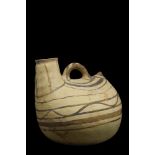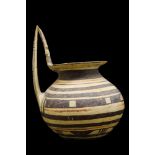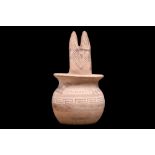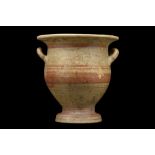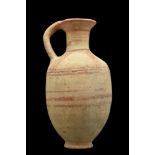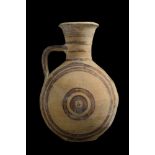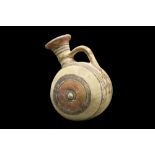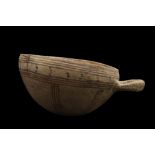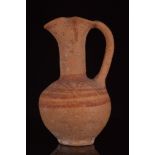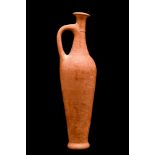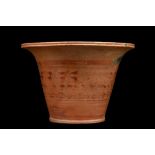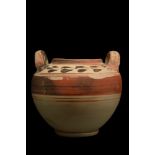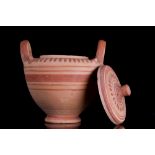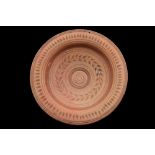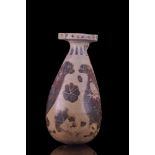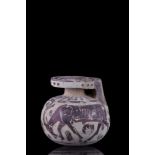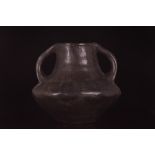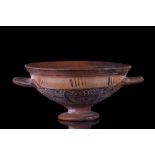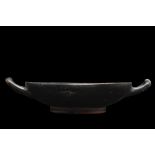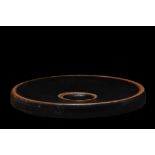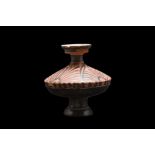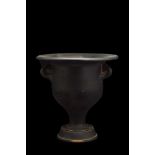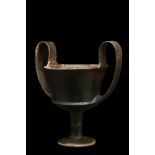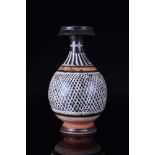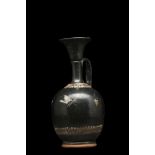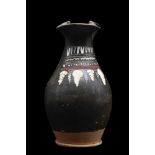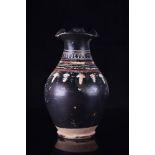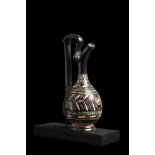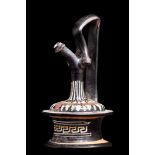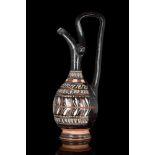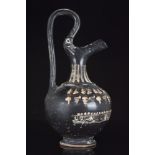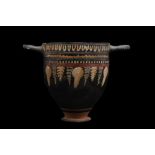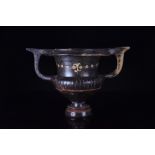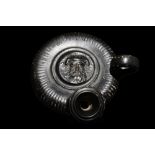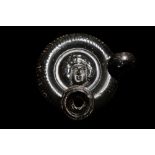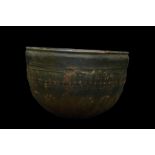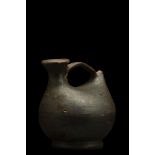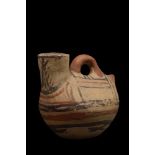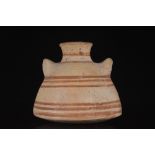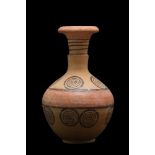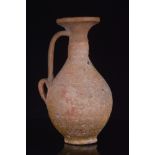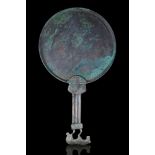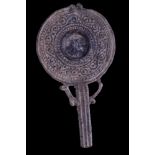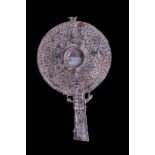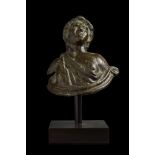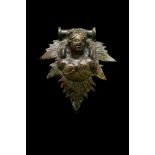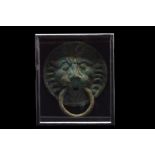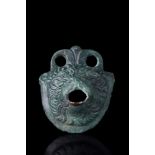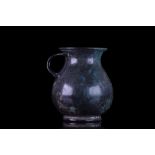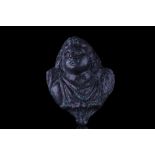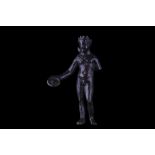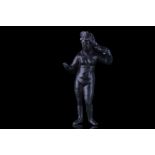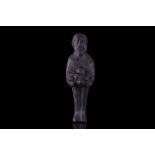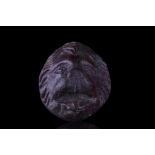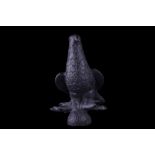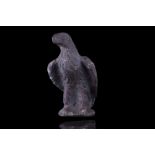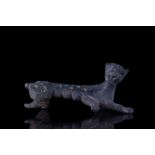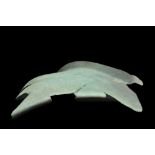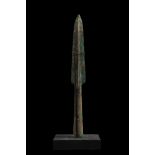Affinez votre recherche
Estimation
Catégorie
- Jewellery (92)
- Greek, Roman, Egyptian & Other Antiquities (85)
- Arms, Armour & Militaria (56)
- Sculpture (41)
- Ceramics (39)
- Coins (37)
- Chinese Works of Art (28)
- Glassware (25)
- Books & Periodicals (16)
- Salvage & Architectural Antiques (14)
- Porcelain (13)
- Collectables (9)
- Taxidermy & Natural History (6)
- Vintage Fashion (6)
- Classic Cars, Motorcycles & Automobilia (4)
- Furniture (4)
- Metalware (4)
- Textiles (4)
- Lighting (2)
- Islamic Works of Art (1)
- Musical Instruments & Memorabilia (1)
- Oil, Acrylic paintings & Mixed Media (1)
- Scientific Instruments (1)
- Stamps (1)
- Tools (1)
- Liste
- Grille
A subscription to the Price Guide is required to view results for auctions ten days or older. Click here for more information
GREEK DAUNIAN POTTERY ASKOS
Ca. 400-300 BC. A Daunian askos referred to as a "duck" askos with a globular body with a cylindrical neck, a flaring mouth, and a wide strap hand...
Ca. 350 BC. A lovely Daunian kyathos with a bulbous body tapering to a flat base. Narrowed neck leading to a broad, flat rim. A high strap handle ...
DAUNIAN POTTERY JAR
Ca. Late 6th/early 5th century BC. A beautiful Daunian jar with a rounded body tapering to a cylindrical neck, an everted tubular rim, and a high ...
Ca. 400 BC. A finely modelled wheel-thrown bichrome terracotta bell krater of a classic form with a flared rim and twin upraised coil-built handle...
CANAANITE HOLY LANDS POTTERY JUG
Ca. 1900 BC. A pottery jug with a strap handle, and an amphora-shaped body. Fine red bands encircle the body, and below the neck are displayed a g...
Cypro-Geometric, Ca. 1050-700 BC. A barrel jug of cream bichrome painted ware, the spherical body with encircling concentric decoration, with cros...
CYPRIOT POTTERY BARREL FLASK
Cypro-Geometric, Ca. 1050-700 BC. Of white painted ware, the spherical body with pronounced nipples and encircling concentric decoration, with cro...
Ca. 1300-1150 BC. A pottery vessel known as a milk bowl displays a tan-coloured ground that is embellished with six groups of vertical linear deco...
Ca. 1900 BC. A fine example of a coil-made, pottery jug with a trefoil spout, a strap handle, and an amphora-shaped body. Fine red bands are aroun...
Late Bronze Age, Ca. 1600-1200 BC. Wheel-made red lustrous bottle with spindle-shaped body with tapered neck fluting near mouth with everted rim, ...
Ca. 300 BC. A terracotta Messapian Kalathos, the body decorated in with two bands of red painted wreaths, in between two red painted bands. Very f...
Ca. 400-300 BC. A Messapian lebes gamikos, a delicately formed "marriage vase" with an inverted bell-shaped body and its characteristic pair of ho...
DAUNIAN LEBES GAMIKOS
Ca. 4th century BC. A Daunian lebes gamikos - "marriage vase" with an inverted bell-shaped body and its characteristic pair of horizontal strap ha...
Ca. 400-300 BC. A pottery plate with a cream background and red painted linear decoration in the tondo enclosed within a laurel band painted in th...
Ca. 600 BC. A beautiful pottery alabastron with a piriform body with a flat disk rim connected by a small loop with a neck. The exterior is adorne...
Ca. 600-500 BC. A pottery aryballos with its characteristic round body, a short neck, and a rimmed mouth with slightly inward sloping sides. A sma...
GREEK BLACKWARE ARYBALLOS
Ca. 500 BC. A blackware aryballos with its characteristic round body, a short neck, and a rimmed mouth. A small handle connects the mouth with the...
VILLANOVAN BLACKWARE IMPASTO JAR
Ca. 1100-700 BC. A well-formed blackware jar with twin symmetrical handles rising from the shoulder. The Villanovan culture is known mostly for th...
ETRUSCO-CORINTHIAN KYLIX
Attributable to the Group of the Phoenician Palmettes, Ca. 580 - 560 BC. A terracotta kylix with a hemispherical bowl, short pedestal foot, and tw...
Ca. 400-300 BC. A stemless terracotta Greek kylix (drinking cup), covered in a rich black gloss. The large, shallow body rests on a low foot that ...
ATTIC BLACKWARE FOOD PLATE
Ca. 400-300 BC. A black-glazed pottery fishplate, having an integral ring foot, wide lower collar rim, and a central circular depression. Two red-...
Ca. 340-325 BC. A ceramic lekanis of the red-figure lid decorated with palmette designs. The lid's knob handle with radiating strokes on top. The ...
Ca. 400-300 BC. A magnificent Campanian terracotta bell krater, executed in black slip. The vessel presents a pedestal base, bell-shaped body, app...
Ca. 400-300 BC. Greek black-glazed kantharos with high attenuated twin handles and a high stemmed foot with a raised ridge. Lovely hints of irides...
Ca. 340-325 BC. A rare bottle created in a pottery workshop in the Apulia region of southern Italy where potters were known for introducing additi...
GREEK GNATHIAN WARE LEKYTHOS
Ca. 400-300 BC. A fine wheel-thrown pottery lekythos with a low ring foot, a tall ovoid body, a discoid rim with a funnel mouth, and an applied ar...
Ca. 340-320 BC. An attractive blackware pottery oinchoe with a trefoil spout, decorated in the Gnathian technique with fugitive red, white, and ye...
Southern Italian, Ca.400-300 BC. A Gnathian oinochoe with trilobate spout, constricted neck, piriform body, ring base and L-shaped handle. The ext...
Ca. 350-300 BC. A metallic black glazed pottery handled oil bottle having a tapered bulbous body, high angular handle, and pour spout, stylized li...
ANCIENT GREEK GNATHIAN EPICHYSIS
Apulia, Southern Italy, Ca. 375–300 BC. A Gnathian-ware epichysis decorated with tongues on the neck, dots, zigzags and berried laurel band on the...
Ca. 400 BC. A delicate, well detailed vessel known as a prochous, formed in a black-glazed, crafted with a tall bulbous body tapering into shaped ...
GREEK GNATHIAN POTTERY PROCHOUS
Ca. 4th century BC. A pouring vessel known as a prochous, wheel-thrown and decorated with a lustrous black glaze. The vessel is defined by its dis...
Ca. 2nd half of the 4th - 1st half of the 3rd Century BC. A particularly nice and well-preserved example of a typical drinking cup from Southern I...
Ca. 350 BC. A black glazed pottery pedestal cup, having a large loop, opposing handles with flat wide thumb rests. Lower tapered bulbous rim with ...
Ca. 3rd century BC. Black glazed terracotta guttos on a small foot with a very wide and short body. On one side of the body, a long and thin spout...
Ca. 360-320 BC. A black-glazed terracotta guttos (oil-lamp filler) with a spool-shaped foot, a wheel-shaped body, a protruding ring handle, and a ...
Eastern Mediterranean, Ca. 1st century BC - 1st century AD. A decorated pottery bowl of very fine detail with a pinkish hue, covered all over in a...
Ca. 340-325 BC. A pottery askos presenting in the form of a 'duck' with a tiered foot, a bulbous body with a concave top, a petite strap handle, a...
DAUNIAN BLACK GLAZED DUCK ASKOS
Ca. 340-325 BC. A pottery askos presenting in the form of a 'duck' with a tiered foot, a bulbous body with a concave top, a petite strap handle, a...
PALAEO-MYCENAEAN PYXIS
Late Bronze Age, Ca.1300 BC. A pyxis in buff terracotta; twin lug handles on the shoulders for suspension (suspension would help in evaporation of...
CYPRIOT POTTERY BICHROME JUGLET
Cypro-Geometric Period, Ca. 1050-700 BC. A decorated pottery juglet with painted salmon color wide band and dark brown painted concentric ring ele...
HERODIAN GREEN GLAZED OINOCHOE
Judea, Ca. 37 BC-70 AD. The body of this juglet is piriform and a small ridge is present just below the cylindrical neck. The rim is thick and eve...
Ca. 5th-4th century BC. A bronze Graeco-Scythian type mirror featuring a circular face which was originally the reflective surface, a handle shape...
Ca. 100-300 AD. A beautiful lead votive mirror, with a circular disk and rectangular handle with scroll-shaped supports. The obverse is covered wi...
Ca. 100-300 AD. A lead votive mirror, with a circular disk and a flat, rectangular handle with small lateral supports. The obverse is covered with...
Ca. 100-300 AD. A massive cast-bronze fitting coming from a chariot depicting a male figure with youthful features (possibly the god Apollo, the R...
Ca. 100-300 AD. Large cast bronze hydria attachment depicting the bust of a siren having a fancy hairdo, expressive facial features, wearing a bel...
Ca. 200-300 AD. A bronze door knock shaped as a lion head handle cast in high relief within a circular border. The animal's head modelled with a p...
Ca. 1st–2nd century AD. A superbly cast lion protome with the rich full mane of overlapping wavy locks, the lion's mouth open wide, the muzzle nat...
Ca. 100-300 AD. A bronze olpe rising from a ring foot. The vessel features a globular lower body tapering to a gracefully-shaped neck and ending w...
Ca. 100-300 AD. A bronze die for casting mounts in the form of a bust of Cupid (Greek Eros) with fleshy features and curly hair. His chubby cheeks...
Ca. 100-300 AD. A bronze figurine of a young Eros, depicted in a standing pose, naked. He is striding forward with his left leg advanced, his righ...
ROMAN BRONZE VENUS FIGURINE
Ca. 1-200 AD. A cast bronze statuette of goddess Venus standing with her weight on her right leg, the left leg bent at the knee and slightly advan...
ROMAN BRONZE PRIAPUS FIGURE
Ca. 100-300 AD. A free-standing bronze statuette of the god Priapus shown with a long beard, standing with erect phallus and a pile of fruit, symb...
ROMAN BRONZE LION HEAD PHALLERA
Ca. 100-200 AD. A cast bronze phalera formed as a lion's mask. The animal's head with prominent brow and eyes, an open mouth, and a detailed mane ...
Ca. 100-200 AD. A cast bronze figurine of an eagle perching on an integral stand. Expertly cleaned and conserved, with a smooth patina. An aquila ...
ROMAN BRONZE EAGLE FIGURINE
Ca. 100 AD. A realistically modelled bronze eagle figurine, standing on a base, long wings folded, the wingtips crossed, feather detailing to the ...
ROMAN BRONZE PANTHER BROOCH
Ca. 100-200 AD. A beautiful bronze panther brooch with a slender, stretched body with recessed circles to accept enamel inlays. Catchplate to the ...
Ca. 1-100 AD. A sheet-bronze cheekpiece from a Coolus type helmet. This type of helmet was usually hammered from bronze and it was most popular du...
Ca. 800-600 BC. A socketed bronze spearhead comprising a substantial lentoid-section blade with raised midrib, and a long shaft. Hoplites were the...

